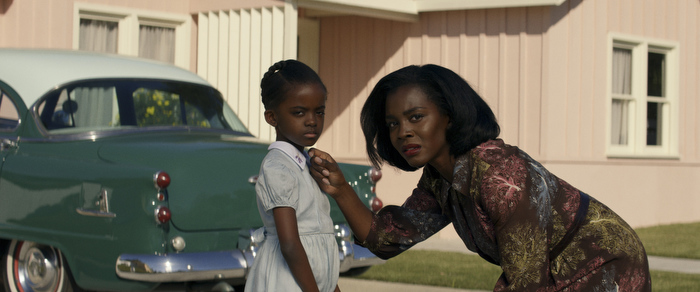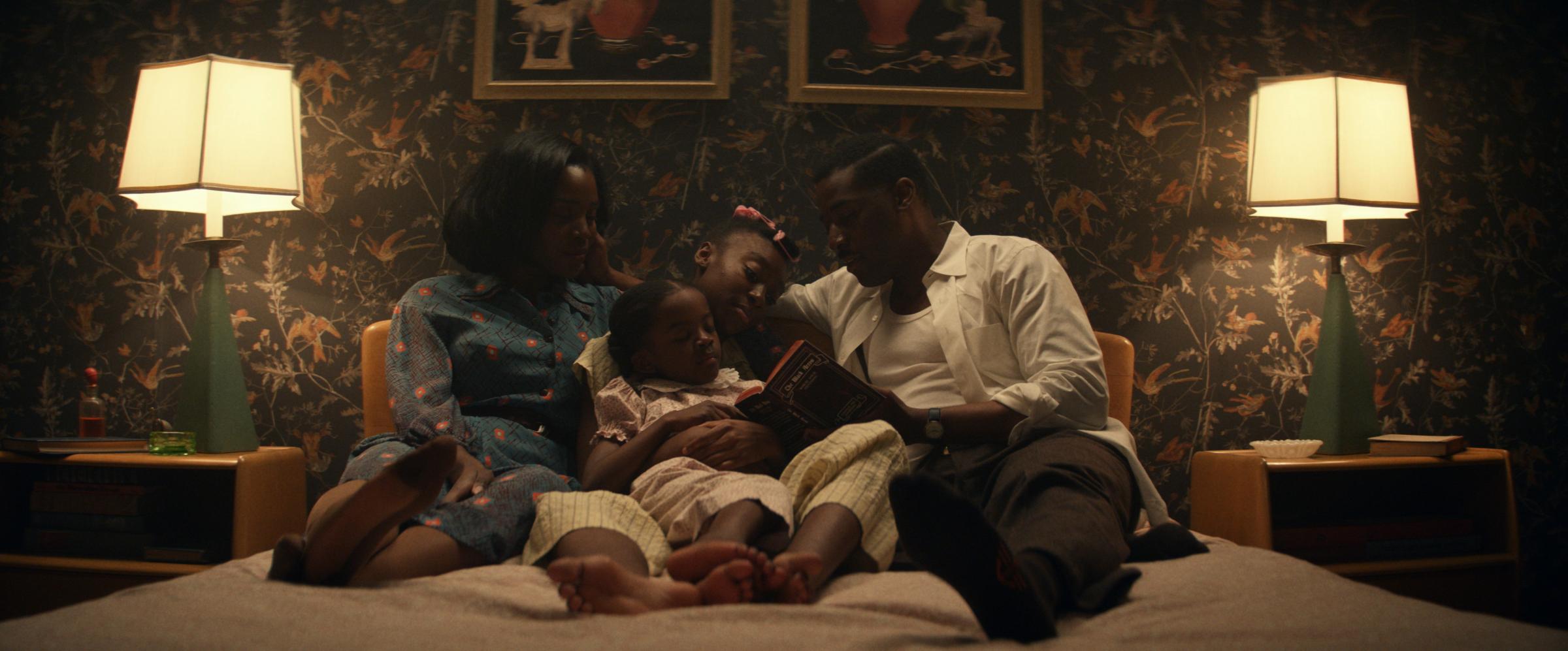This post discusses, in detail, major plot points of the Amazon Prime Video series Them: Covenant.
It isn’t often anymore, now that we have so much TV on so many platforms, that an upcoming show achieves the visibility to draw controversy before anyone has seen it. But, for better or worse, Amazon’s anthology series Them broke through the static. When a trailer for the first season, subtitled Covenant, dropped in March, many viewers took to social media to express frustration with what looked to be yet another pop-culture product that dramatized Black pain. Its premiere on Prime Video Friday was greeted with the L.A. Times headline “The racist violence in Amazon’s new series left execs ‘shaken.’ Does it go too far?” and a robust Twitter debate over executive producer Lena Waithe’s history with graphic depictions of Black suffering.
The opening salvo from a show that, according to its promotional materials, “explores terror in America,” the 1950s-set Them: Covenant follows a Black family who flee tragedy in North Carolina, only to face new racist threats on the outskirts of Los Angeles. (As this description suggests and many critics have noted, Them overlaps significantly with Lovecraft Country, American Horror Story and Jordan Peele’s Us.) This makes Henry (Ashley Thomas) and Livia “Lucky” Emory (Deborah Ayorinde), along with their daughters Ruby Lee (Shahadi Wright Joseph) and Gracie Jean (Melody Hurd), part of the Great Migration that brought Black Americans out of the Jim Crow South in the mid-20th century. The upwardly mobile Emorys buy a house in Compton, which was then overwhelmingly white and anti-integration. This American dream becomes a nightmare when the family’s neighbors launch a campaign of harassment, vandalism and escalating violence aimed at driving them out.
The season’s title refers to the restrictive covenants that barred Black people from buying homes in many communities across the U.S. and remained common even after a 1948 Supreme Court ruling rendered them legally unenforceable. It’s an ingenious premise for the horror subgenre that has been called, most famously by Peele, the social thriller. And while Twitter, the place nuance goes to die, might convince you that the show is either flawless or a crime against humanity, the truth is more complex. There’s plenty to admire about Covenant: strong performances in each of the physically and emotionally demanding central roles; tight, tense direction, especially in the episodes helmed by horror auteur Ti West; production design that creates a jarring contrast between the desaturated, cupcake-frosting pastels of mid-century Compton and the Emorys’ dark skin, as if the very buildings were rejecting their presence. From a thematic standpoint, I was struck by the show’s exploration of how society can gaslight its scapegoats into believing—and thus embodying—the worst stereotypes about themselves.

But these strengths feel pretty separate from the elements that have spurred such a backlash to first-time creator Little Marvin’s series. Plenty of Covenant’s violence is of the cartoonish, horror-movie variety; in an effective jump-scare from the premiere, for instance, a figure jumps out of the shadows and grabs Gracie Jean. Other violent scenes are more realistic, or at least more focused on the physical and psychological pain of characters who are usually Black. (It’s not that white people don’t get injured or killed, but when they do, the ordeal tends to be brief.) In a flashback that is the show’s most harrowing sequence, Lucky is raped, then forced to watch three white assailants stuff her baby son in a pillowcase and throw him around until he dies.
This is devastating to watch. Neither the episode’s writers, Little Marvin and Dominic Orlando, nor its director Janicza Bravo (Zola) minimize Lucky’s trauma in the moment. Ayorinde gives the season’s most arresting performance, and she is as convincing as ever here. Yet by situating the scene of realistic rape and child murder within the context of the horror genre, which typically mines blood and guts for thrills, the show still links a real history of racist, gendered violence to violence as entertainment. (A statement to press takes pains to distinguish between horror and what the Emory family experiences: “Little Marvin notes that while very few of us will ever experience actual supernatural horror in our lives, terror is something we’ve all experienced.” But the series relies so heavily on the aesthetics and tropes of horror that the distinction is semantic.) As NPR’s Aisha Harris put it: “The attention to the details of [the characters’] suffering is chilling not necessarily because of what is depicted—there’s a time and place for such explicitness in the right creative hands—but because it’s depicted in service of a cynical mode of storytelling.”
In part because the script has already conveyed that the Emory family survived something unspeakable in North Carolina and in part because contemporary audiences regularly witness so much real violence against Black people on the news and via social media, the scene isn’t even edifying. Though it elicits visceral responses—anger, sorrow, revulsion—it doesn’t tell us anything we don’t already know. This is not to say that every graphic representation of child murder or sexual assault in a visual medium is equally gratuitous. Early episodes of Hulu’s The Handmaid’s Tale had a compelling reason to show the sick rituals that brought powerful men and their sterile wives together to enforce handmaids’ sexual servitude: it helped viewers wrap their minds around the brutal perversity of a fictional dystopian regime founded on state-sponsored rape. The show crossed a line into exploitation when it continued making a spectacle of violence against women, in all its forms, over the course of three excruciating seasons. Instead of facilitating social commentary, the torture started to feel like an end in itself.

It’s no coincidence that The Handmaid’s Tale is a work of speculative fiction. The past decade has seen simultaneous spikes in genre entertainment—sci-fi, fantasy, superheroes, horror—and in entertainment with an overt political or social message. So, inevitably, the two trends now converge more frequently than they once did. Sometimes that convergence is breathtaking. Only horror could provide indelible metaphors for oppression like Get Out’s “sunken place” or, two generations earlier, the premise of The Stepford Wives. While it faltered in some of its allegories, Lovecraft Country used body horror to profound effect in a story line that had a Black woman literally shedding her skin to inhabit the body of a petite white woman, in a striking encapsulation of the harm caused by white-supremacist beauty standards.
In many other cases, the result of using the tropes of so-called low culture as a vehicle for high-minded commentary has been a misguided, potentially offensive muddle. The defining series of the 2010s, Game of Thrones, faced multiple fan-driven reckonings over its stereotypical depictions of nonwhite characters, as well as how and why it incorporated sexual violence. But the Covenant controversy reminds me more of the response to last year’s irredeemable Hunters (another release from Amazon, whose frequent investment in senseless carnage—see also: Utopia—suggests the blame isn’t limited to Waithe and Little Marvin). Another politically minded show in a genre that thrives on violence as entertainment—action comedy—it follows the adventures of Nazi hunters, in episodes that include both pulpy, Tarantino-esque revenge fantasies and somber scenes of Jews suffering and dying in the Holocaust. There is room for the representation of both things in art, but they simply don’t mix.
In her influential book On Photography, Susan Sontag outlines her reservations about images that document real human misery. “Photographs shock insofar as they show something novel,” she writes. “Unfortunately, the ante keeps getting raised—partly through the very proliferation of such images of horror.” The result is “art that is a self-willed test of hardness,” which some will consume “not to feel more but to feel less.” This observation, from 1977, feels all too prescient now, in an age of ultra-real video games and near-daily mass shootings. And so, to the extent that it’s still possible for artistic portrayals of realistic atrocities and realistic oppression to make an emotional impact on viewers, whether as fiction or nonfiction, it’s imperative that they aren’t diluted or conflated with cartoon violence. There are many justifiably bold, thought-provoking creative choices in Covenant, but the decision to combine allegorical horror with sadistic realism is not one of them.
More Must-Reads from TIME
- Caitlin Clark Is TIME's 2024 Athlete of the Year
- Where Trump 2.0 Will Differ From 1.0
- Is Intermittent Fasting Good or Bad for You?
- The 100 Must-Read Books of 2024
- Column: If Optimism Feels Ridiculous Now, Try Hope
- The Future of Climate Action Is Trade Policy
- FX’s Say Nothing Is the Must-Watch Political Thriller of 2024
- Merle Bombardieri Is Helping People Make the Baby Decision
Contact us at letters@time.com